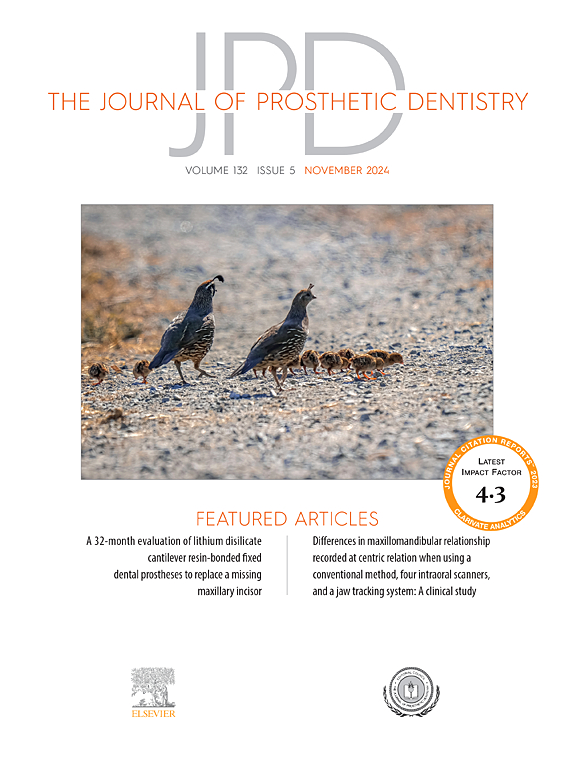Trueness and intaglio fit of custom-made polyetheretherketone post-and-cores fabricated using different techniques
IF 4.3
2区 医学
Q1 DENTISTRY, ORAL SURGERY & MEDICINE
引用次数: 0
Abstract
Statement of problem
Applications of polyetheretherketone (PEEK) as a promising alternative to ceramic materials have extended to include post-and-cores. However, information regarding the available fabrication techniques for producing custom-made PEEK post-and-cores and their effect on accuracy is still scarce.
Purpose
The purpose of this in vitro study was to evaluate the trueness and intaglio fit of custom-made PEEK post-and-cores fabricated using different techniques.
Material and methods
Ten mandibular second premolars were collected, decoronated, and endodontically treated. For the fabrication of custom-made post-and-cores, each post space was prepared, scanned, and designed by using the exocad software program. Each reference design was used to fabricate PEEK post-and-cores with 3 different techniques (N=30): group P, heat pressing; group S, subtractive manufacturing, and group A, additive manufacturing. All the fabricated restorations were scanned, providing the test data as standard tessellation language (STL) files, which were imported with the reference data into a reverse engineering software program to evaluate the 3D trueness of each fabrication technique. To evaluate the intaglio fit, restorations coated with silicone material were scanned to provide the test data as STL files, which were superimposed on the STL files of the scanned restorations. One-way analysis of variance (ANOVA) and 2-way mixed model ANOVA tests were used to analyze the data (α=.05).
Results
For 3D trueness, root mean square (RMS) values representing the deviations between the scans of the fabricated restorations and the reference designs varied significantly among different groups (P<.001), with the highest mean deviation found in group A (102.8 ±31 µm), while the lowest mean deviation was found in group S (42.2 ±11 µm). For the intaglio fit, the deviations between the scans of the fabricated restorations and the scans of the coated restorations varied significantly among different groups (P<.001), with the highest mean deviation found in group A (228.4 ±47 µm), while the lowest mean deviation was found in group S (96.2 ±14 µm). Simple effects comparisons showed the highest value of deviation in the apical area in group A (P<.001).
Conclusions
Custom-made PEEK post-and-cores fabricated by using subtractive manufacturing and heat pressing techniques showed better trueness and intaglio fit compared with additively manufactured restorations. Before printed PEEK restorations can be considered a suitable alternative to pressed or milled ones, improvements are required to confirm their reliability.
使用不同技术制作的定制聚醚醚酮柱形齿模的真实性和凹版贴合度。
问题陈述:聚醚醚酮(PEEK)作为陶瓷材料的一种很有前途的替代材料,其应用范围已扩展到后牙槽。目的:本体外研究的目的是评估使用不同技术制作的定制 PEEK 基台的真实度和凹槽密合度:收集十颗下颌第二前磨牙,对其进行装饰和根管治疗。为了制作特制的桩核,使用 exocad 软件程序对每个桩间隙进行制备、扫描和设计。每个参考设计均采用 3 种不同的技术(N=30)制作 PEEK 基桩和基台:P 组采用热压技术;S 组采用减法制造技术;A 组采用加法制造技术。对所有制作好的修复体进行扫描,以标准细分语言(STL)文件的形式提供测试数据,并与参考数据一起导入逆向工程软件程序,以评估每种制作技术的三维真实性。为了评估凹模配合度,对涂有硅树脂材料的修复体进行了扫描,以提供标准细分语言(STL)文件形式的测试数据,并将其叠加到扫描修复体的标准细分语言(STL)文件上。采用单因素方差分析(ANOVA)和双因素混合模型方差分析检验来分析数据(α=.05):在三维真实性方面,代表制作的修复体扫描结果与参考设计之间偏差的均方根值在不同组别之间存在显著差异(PConclusions:使用减法制造和热压技术制作的定制 PEEK 后牙与加法制造的修复体相比,显示出更好的真实度和凹面贴合度。在将印刷 PEEK 修复体视为冲压或研磨修复体的合适替代品之前,需要对其可靠性进行改进。
本文章由计算机程序翻译,如有差异,请以英文原文为准。
求助全文
约1分钟内获得全文
求助全文
来源期刊

Journal of Prosthetic Dentistry
医学-牙科与口腔外科
CiteScore
7.00
自引率
13.00%
发文量
599
审稿时长
69 days
期刊介绍:
The Journal of Prosthetic Dentistry is the leading professional journal devoted exclusively to prosthetic and restorative dentistry. The Journal is the official publication for 24 leading U.S. international prosthodontic organizations. The monthly publication features timely, original peer-reviewed articles on the newest techniques, dental materials, and research findings. The Journal serves prosthodontists and dentists in advanced practice, and features color photos that illustrate many step-by-step procedures. The Journal of Prosthetic Dentistry is included in Index Medicus and CINAHL.
 求助内容:
求助内容: 应助结果提醒方式:
应助结果提醒方式:


